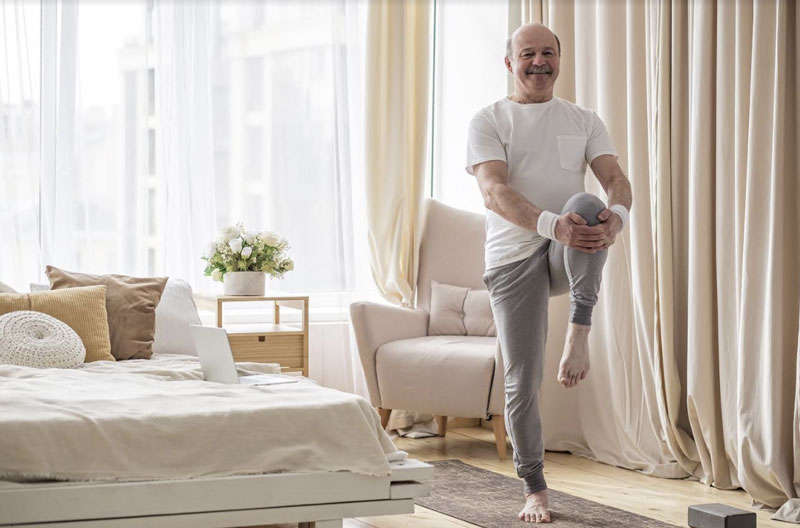Falling is not a normal part of aging, according to the Centers for Disease Control and Prevention (CDC). But still, they are not uncommon. In fact, every second of every day, an older adult falls in the U.S. making this the leading cause of injury.
One out of every five falls results in an injury, such as a broken bone or head injury and more than 95% of hip fractures are caused by falling. Each year, three million older adults go to an emergency room for treatment of a fall injury.
The great news is that you can learn to lower your risk of falling, which in turn can keep you upright and independent longer.
Causes of falling and their resulting injuries
There are several reasons you may find yourself unsteady or falling and many of them can be addressed to lower your risk, including:
-
Physical changes or conditions
-
Medications
-
Eyesight
-
Tripping over cords, rugs or pets
-
Loss of balance
Preventing falls: steps you can take
Since falling isn’t an inevitable conclusion of growing older, it’s important to take the steps you can to help keep you on your feet. Consider these suggestions:
Step 1. Talk to your doctor
Discuss with your doctor your fall risk and any physical problems that may increase your chance of falling. Also, provide a list of medications you take, including over-the-counter. There may be side effects or interactions with other medications that increase your risk of falling.
Be sure to discuss any health conditions or symptoms you’re experiencing. A few examples could include dizziness, shortness of breath, joint pain, numbness in your feet or legs or loss of balance.
It’s also important to tell your doctor if you have fallen before and the details. There may be clues that your doctor can use to help with strategies and prevention tips.
Step 2. Keep moving
Physical activity is one of the best steps you can take. Not only does it build muscle strength, but you should also experience better balance, coordination and flexibility.
If you find yourself avoiding activity due to other physical conditions or you fear falling, talk to your doctor. Becoming sedentary is detrimental to your health.
You may be prescribed an exercise program you can undergo while being carefully monitored by a physical therapist. There are exercises that can help improve your balance, flexibility, muscle strength and gait. This can also help you gain confidence in movement.
Step 3. Wear the right shoes
Shoes may help you make a fashion statement but you won’t want to do that at the expense of falling and becoming injured. Take a look at your footwear and make sure they are sturdy and provide good support for your feet.
You don’t necessarily need to forego style with today’s wide selection of shoes to choose from. But always take into consideration where you will be going and what surfaces you’ll be walking on. Non-skid soles and shoes that fit properly should always be the priority.
Step 4. Prevent falls at home
Take a tour of your home, inside and out, and determine its safety when it comes to causing a fall or at least increasing the risk. Look for these conditions:
-
Stairs and steps with no handrails
-
Newspapers, magazines, books or other objects in the home’s walkways
-
Electrical and phone cords in the walkways that could easily cause you to trip
-
Coffee tables or other furniture in high-traffic areas that must be navigated
-
Rugs in the walkway or elsewhere that could cause tripping
-
Loose floorboards, tiles or carpeting that’s creating a stumbling hazard
Step 5. Light up your space
Being able to clearly see where you’re going can make a big difference when considering your risk of falling. Be careful with shadows or other conditions that make it harder to differentiate any changes in floor levels. These tips can help:
-
Install night lights in your bedroom, bathroom and hallways.
-
Place a lamp by your bedside if needed in the middle of the night.
-
Have a clear pathway to the light switch if the room is dark. Consider installing illuminated switches.
-
Turn on the lights before going up or down the stairs.
-
Store flashlights and batteries where they can easily be retrieved in case you lose power.
Source: Mayo Clinic
Avoid the fear of falling
You want to prevent falls but you don’t want to live in fear. A significant concern is that once a person falls, the experience may be frightening enough to stop them from remaining active. Some people will stay home rather than take the chance of falling again.
If you need help, talk to your doctor. Otherwise, be careful, but remind yourself that people can also fall when they’re younger too and then take the necessary steps to remain safe.
Ingleside’s Westminster at Lake Ridge Independent Living
Preventing falls should be a priority and the steps you take today can pay off in the long run. Remaining active is a vital part of aging well and we hope the above information is helpful for you to achieve your optimum health.
At Ingleside’s Westminster at Lake Ridge Independent Living community, you’ll find yourself living among retirees who know how to get the most out of life.
Take a look at what our vibrant community has to offer:
-
Your choice of cottage or apartment home
-
Open one or two-bedroom floor plans that you can personalize to make your own
-
Maintenance-free lifestyle
-
Chef-prepared meals in our elegant dining room or casual café
-
Fully equipped fitness center
-
Heated indoor swimming pool
-
Woodworking shop
-
Two fishing ponds
-
Indoor greenhouse
-
Beautiful walking trails through our 62 wooded acres
Please visit our website for more information or call (703) 420-7105 if you have any questions or would like to schedule a personalized tour today.

